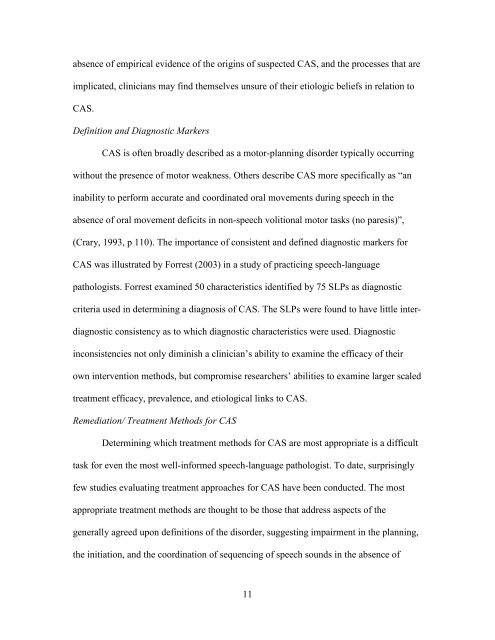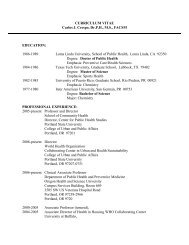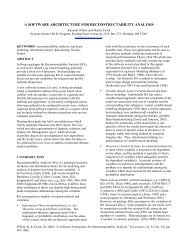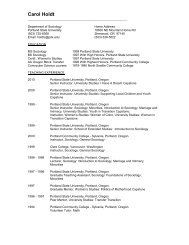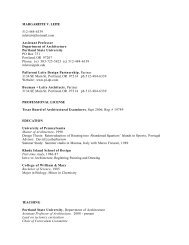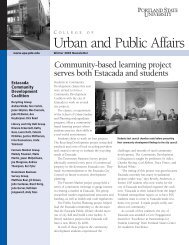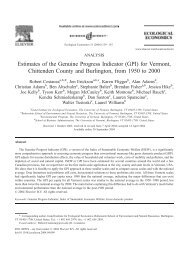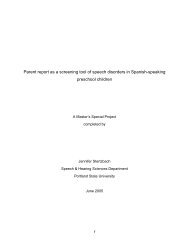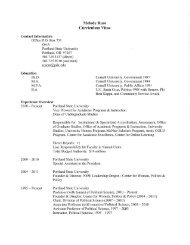Effects of integral stimulation therapy on speech - Portland State ...
Effects of integral stimulation therapy on speech - Portland State ...
Effects of integral stimulation therapy on speech - Portland State ...
You also want an ePaper? Increase the reach of your titles
YUMPU automatically turns print PDFs into web optimized ePapers that Google loves.
absence <str<strong>on</strong>g>of</str<strong>on</strong>g> empirical evidence <str<strong>on</strong>g>of</str<strong>on</strong>g> the origins <str<strong>on</strong>g>of</str<strong>on</strong>g> suspected CAS, and the processes that are<br />
implicated, clinicians may find themselves unsure <str<strong>on</strong>g>of</str<strong>on</strong>g> their etiologic beliefs in relati<strong>on</strong> to<br />
CAS.<br />
Definiti<strong>on</strong> and Diagnostic Markers<br />
CAS is <str<strong>on</strong>g>of</str<strong>on</strong>g>ten broadly described as a motor-planning disorder typically occurring<br />
without the presence <str<strong>on</strong>g>of</str<strong>on</strong>g> motor weakness. Others describe CAS more specifically as “an<br />
inability to perform accurate and coordinated oral movements during <strong>speech</strong> in the<br />
absence <str<strong>on</strong>g>of</str<strong>on</strong>g> oral movement deficits in n<strong>on</strong>-<strong>speech</strong> voliti<strong>on</strong>al motor tasks (no paresis)”,<br />
(Crary, 1993, p 110). The importance <str<strong>on</strong>g>of</str<strong>on</strong>g> c<strong>on</strong>sistent and defined diagnostic markers for<br />
CAS was illustrated by Forrest (2003) in a study <str<strong>on</strong>g>of</str<strong>on</strong>g> practicing <strong>speech</strong>-language<br />
pathologists. Forrest examined 50 characteristics identified by 75 SLPs as diagnostic<br />
criteria used in determining a diagnosis <str<strong>on</strong>g>of</str<strong>on</strong>g> CAS. The SLPs were found to have little interdiagnostic<br />
c<strong>on</strong>sistency as to which diagnostic characteristics were used. Diagnostic<br />
inc<strong>on</strong>sistencies not <strong>on</strong>ly diminish a clinician’s ability to examine the efficacy <str<strong>on</strong>g>of</str<strong>on</strong>g> their<br />
own interventi<strong>on</strong> methods, but compromise researchers’ abilities to examine larger scaled<br />
treatment efficacy, prevalence, and etiological links to CAS.<br />
Remediati<strong>on</strong>/ Treatment Methods for CAS<br />
Determining which treatment methods for CAS are most appropriate is a difficult<br />
task for even the most well-informed <strong>speech</strong>-language pathologist. To date, surprisingly<br />
few studies evaluating treatment approaches for CAS have been c<strong>on</strong>ducted. The most<br />
appropriate treatment methods are thought to be those that address aspects <str<strong>on</strong>g>of</str<strong>on</strong>g> the<br />
generally agreed up<strong>on</strong> definiti<strong>on</strong>s <str<strong>on</strong>g>of</str<strong>on</strong>g> the disorder, suggesting impairment in the planning,<br />
the initiati<strong>on</strong>, and the coordinati<strong>on</strong> <str<strong>on</strong>g>of</str<strong>on</strong>g> sequencing <str<strong>on</strong>g>of</str<strong>on</strong>g> <strong>speech</strong> sounds in the absence <str<strong>on</strong>g>of</str<strong>on</strong>g><br />
11


